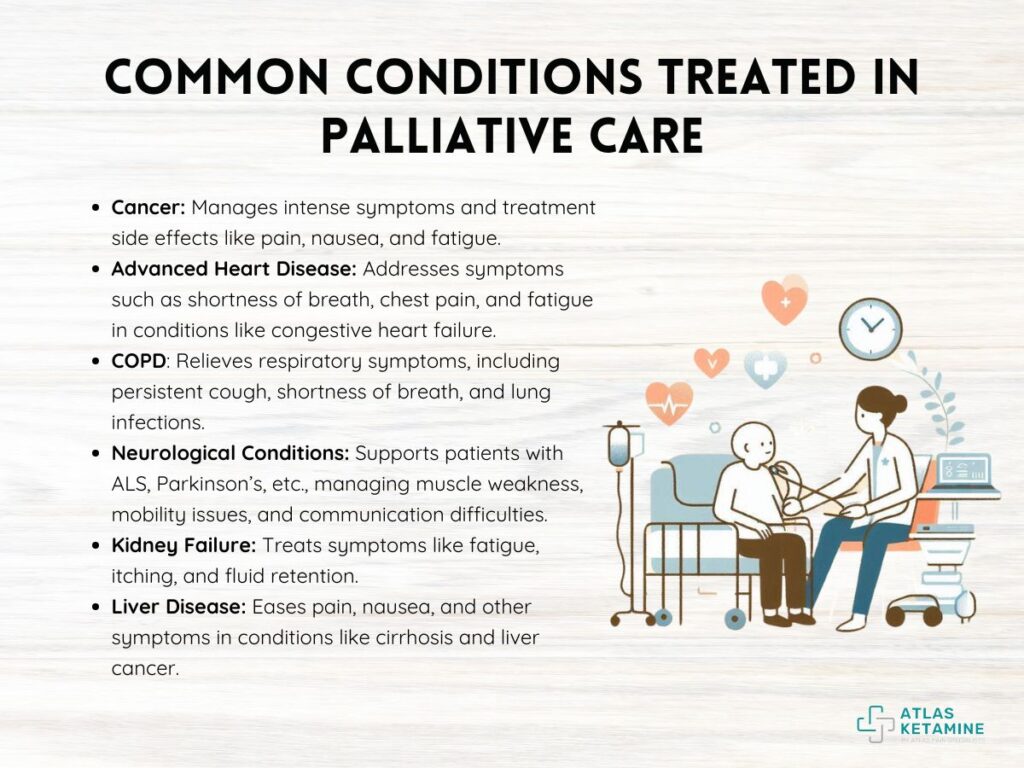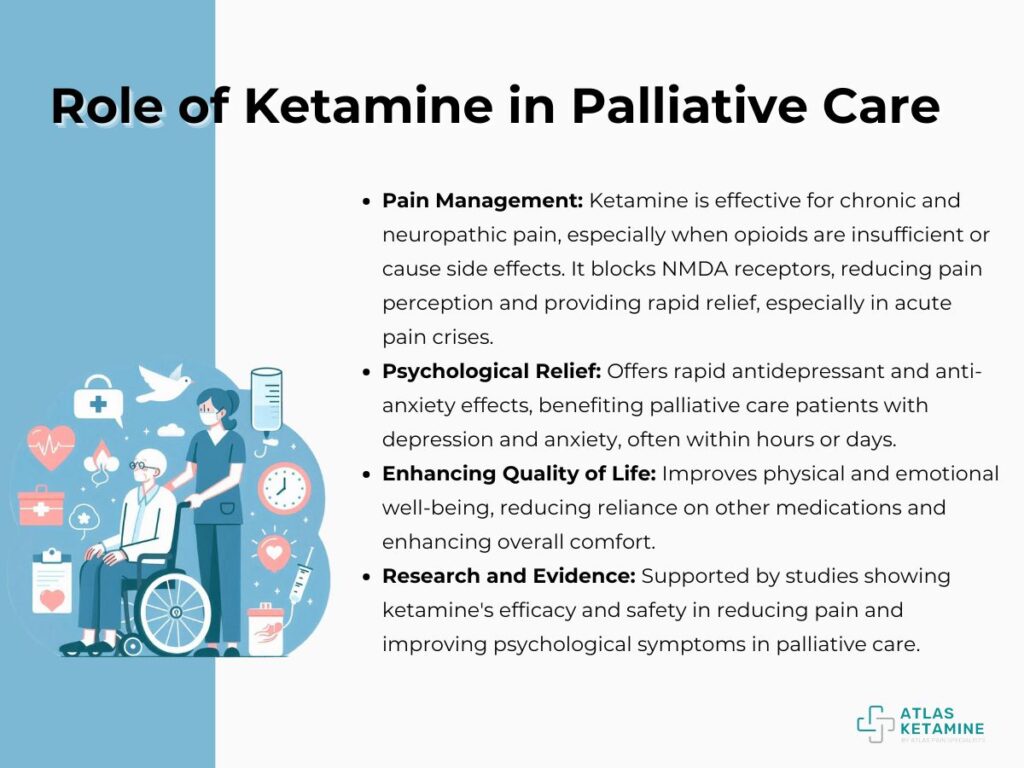Palliative care is a specialized medical approach focused on providing relief from the symptoms and stress of serious illness. The goal is to improve the quality of life for both the patient and their family.
This holistic care encompasses physical, emotional, and spiritual support, ensuring that patients can live as comfortably and fully as possible. Within this context, managing pain and other distressing symptoms is a critical component, often requiring innovative and effective treatment strategies.
Ketamine, a medication traditionally used for anesthesia, has emerged as a promising option in the realm of palliative care. Its unique properties and rapid action in alleviating pain and depression make it a valuable tool for enhancing patient comfort and well-being. Let's explore ketamine's role in palliative care.
What is Palliative Care?
Palliative care is a comprehensive approach to treating individuals with serious, often life-limiting illnesses. This form of care is designed to provide relief from the symptoms, pain, and stress associated with these conditions.
Unlike other forms of medical treatment that focus primarily on curing the illness, palliative care aims to improve the quality of life for both the patient and their family. One of the core principles of palliative care is its patient-centered approach.
This means that care plans are customized to meet the specific needs and preferences of the patient. Palliative care teams typically include a diverse group of healthcare professionals, such as doctors, nurses, social workers, and chaplains, who work together to provide coordinated and compassionate care.
Common Conditions Treated in Palliative Care
Palliative care is essential for managing the complexities of serious illnesses, providing patients with relief from symptoms and stress. This care can be integrated at any stage of illness, offering a supportive layer to traditional treatments.

It addresses both physical and emotional symptoms, helping to manage pain, improve comfort, and support the patient and their family. The following are some of the most common conditions treated in palliative care:
- Cancer: Cancer patients often face intense symptoms and side effects from treatments like chemotherapy and radiation.
- Advanced Heart Disease: Patients with advanced heart disease, such as congestive heart failure, experience symptoms like shortness of breath, fatigue, and chest pain.
- Chronic Obstructive Pulmonary Disease (COPD): COPD causes significant respiratory symptoms, including persistent cough, shortness of breath, and frequent lung infections.
- Neurological Conditions: Neurological conditions like ALS (Amyotrophic Lateral Sclerosis) and Parkinson’s disease present unique challenges, including muscle weakness, mobility issues, and communication difficulties.
- Kidney Failure: Patients with kidney failure may experience symptoms such as fatigue, itching, and fluid retention.
- Liver Disease: Liver disease, including cirrhosis and liver cancer, can cause significant pain, nausea, and other symptoms.
Challenges in Palliative Care
Palliative care, while immensely beneficial, comes with its own set of challenges. These challenges can impact both patients and healthcare providers, necessitating a multifaceted approach to care.
Effective palliative care requires coordination among various healthcare providers and continuous communication with patients and their families. This level of care can be difficult to maintain, especially in resource-limited settings.
1. Managing Complex Pain and Symptoms
Patients in palliative care often experience a range of symptoms, from chronic pain to severe fatigue and nausea. Managing these symptoms requires a nuanced approach, as each patient’s needs are unique and can change rapidly.
Finding the right balance of medications and therapies to provide relief without causing excessive side effects is a continuous challenge. Symptoms like neuropathic pain, which are resistant to traditional painkillers, necessitate the use of advanced pain management techniques.
These can include interventional procedures, alternative therapies, and medications like ketamine, which require careful monitoring and expertise to administer safely.
2. Emotional and Psychological Distress
Serious illnesses bring significant emotional and psychological burdens for both patients and their families. Depression, anxiety, and existential distress are common, and these mental health issues can exacerbate physical symptoms.
Providing comprehensive emotional support is critical but challenging, as it requires skilled mental health professionals and ongoing counseling. Patients often struggle with fears about the future, concerns about the burden on their families, and grief over the loss of their health.
3. Coordinating Care Among Multiple Healthcare Providers
Palliative care often involves a team of healthcare providers, including doctors, nurses, social workers, and specialists. Coordinating care among this diverse team can be difficult, particularly when different providers have varying approaches and treatment philosophies.
Effective communication is essential to ensure that all team members are on the same page regarding the patient's care plan. Patients in palliative care frequently see multiple specialists, which can lead to fragmented care if not well-coordinated.
3. Resource Limitations
In many healthcare settings, resources for palliative care are limited. This can include shortages of trained palliative care professionals, limited access to essential medications, and insufficient funding for comprehensive care programs.
These resource constraints can limit the availability and quality of palliative care services, making it difficult to provide the level of care that patients need. These resource limitations requires advocacy, education, and policy changes to ensure that palliative care is recognized as a critical component of healthcare.
The Role of Ketamine in Palliative Care
Ketamine, traditionally known as an anesthetic, has found a significant role in palliative care due to its unique properties. Its use in this field is gaining attention for its effectiveness in managing complex pain and psychological symptoms, providing relief that other medications may not offer.
The benefits of ketamine in palliative care extend beyond pain management. Given that depression and anxiety are prevalent in individuals with terminal illnesses, this treatment option offers a variety of benefits for complete symptom relief.

1. Pain Management
Ketamine is highly effective in managing chronic and neuropathic pain, which are common and often debilitating in palliative care patients. Unlike traditional opioids, ketamine works by blocking NMDA receptors in the brain, which play a key role in pain transmission and perception.
This mechanism allows ketamine to provide relief for pain types that are resistant to opioids, such as neuropathic pain. The use of ketamine can lead to significant pain reduction, improving patients’ ability to engage in daily activities and enhancing their overall quality of life.
It is particularly useful for patients who have developed tolerance to opioids or are experiencing side effects from long-term opioid use. Ketamine’s rapid onset of action also makes it a valuable option for acute pain crises.
2. Psychological Symptom Relief
In addition to its analgesic properties, ketamine has shown remarkable efficacy in treating depression and anxiety, which are prevalent among palliative care patients. Its antidepressant effects are often rapid, with patients experiencing relief within hours to days, unlike traditional antidepressants that can take weeks to become effective.
This quick action is particularly beneficial for patients in palliative care, who may not have the luxury of time. Ketamine’s ability to alleviate depression and anxiety can lead to significant improvements in patients’ emotional well-being and overall quality of life.
3. Enhancing Quality of Life
Overall, ketamine's use in palliative care is centered on enhancing patients' quality of life. By effectively managing both physical and psychological symptoms, ketamine helps patients experience greater comfort and emotional stability.
This holistic approach aligns with the core goals of palliative care, which focus on relieving suffering and improving life quality for patients with serious illnesses. Patients receiving ketamine often report significant improvements in their mood, reduced reliance on other medications, and a greater sense of well-being.
These benefits not only help patients directly but also provide relief to caregivers and families, who can see their loved ones experiencing less distress and greater peace.
4. Research and Evidence
Numerous studies and clinical trials have supported the use of ketamine in palliative care, demonstrating its efficacy and safety. Research has shown that ketamine can significantly reduce pain levels and improve psychological symptoms in patients with serious illnesses.
These findings have led to increased acceptance of ketamine as a valuable treatment option in palliative care settings. Ongoing research continues to explore the full potential of ketamine in palliative care, including its long-term effects and optimal dosing strategies.
Administration and Safety of Ketamine in Palliative Care
The administration of ketamine in palliative care requires careful consideration to ensure its effectiveness and safety. Given its powerful effects, ketamine must be used under strict medical supervision with appropriate dosing and monitoring.
Safety in administering ketamine revolves around monitoring for potential side effects and ensuring proper dosage. This necessitates a comprehensive approach involving a multidisciplinary team to manage the complexities associated with ketamine use in palliative care settings.
Here are key aspects of administering ketamine safely:
Methods of Administration
Ketamine can be administered in several ways, each with its own advantages and considerations. The choice of method depends on the patient's condition, the desired speed of symptom relief, and the overall treatment plan.
- Intravenous (IV) Infusions: IV administration is the most common method in palliative care. It allows for precise control over dosing and rapid onset of effects, making it ideal for acute pain crises and severe psychological symptoms. IV infusions can be adjusted quickly to manage side effects and ensure optimal symptom relief.
- Oral and Sublingual Options: For patients who cannot tolerate IV infusions or need long-term symptom management, oral and sublingual ketamine provide convenient alternatives. While these methods have a slower onset and less precise dosing than IV administration, they are effective for ongoing pain and psychological symptom management.
- Nasal Sprays: Ketamine nasal sprays offer another non-invasive administration route. This method provides relatively fast absorption and is useful for patients needing quick relief without the invasiveness of IV infusions. Nasal sprays can be a practical option for at-home use under close medical supervision.
Safety and Monitoring
Ensuring the safety of ketamine use in palliative care involves rigorous monitoring and adherence to established protocols. Here are essential safety measures:
- Dosing and Titration: Ketamine dosing must be individualized based on the patient's needs and response to treatment. Starting with a low dose and gradually increasing (titration) helps minimize side effects and achieve the desired therapeutic effect.
- Monitoring for Side Effects: Common side effects of ketamine include dizziness, confusion, elevated blood pressure, and hallucinations. Monitoring patients closely during and after administration is vital to manage these side effects promptly. In a palliative care setting, the goal is to balance symptom relief with maintaining the patient's comfort and cognitive function.
- Multidisciplinary Approach: Effective ketamine administration requires collaboration among healthcare providers, including doctors, nurses, and pharmacists. This team-based approach ensures comprehensive care, addressing all aspects of the patient's health and well-being.
- Patient and Family Education: Educating patients and their families about ketamine, its effects, and potential side effects is critical. Clear communication helps set realistic expectations and ensures that patients and their families are informed participants in the care process.
Understanding The Science Of Ketamine Infusions
Ketamine represents a powerful and versatile tool in the realm of palliative care, offering rapid and effective relief for patients suffering from severe and refractory symptoms. The ability to alleviate pain, reduce anxiety, and improve mood makes ketamine an invaluable addition to the therapeutic options available in palliative care settings.
Ketamine infusions are a key method of administration that allows for precise control over dosing and rapid symptom relief. The science behind how ketamine works provides a foundation for its application in palliative care.
The detailed understanding of how ketamine interacts with the body informs clinical decisions, from selecting the appropriate administration route to adjusting dosages for optimal effect. This bridges the gap between theory and practice, enabling healthcare providers to deliver targeted and effective treatments.
